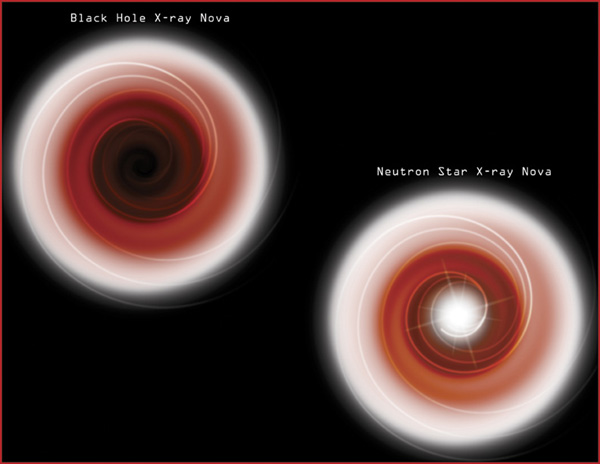
|
Credit & Copyright: M. Weiss, CXC
Explanation:
Q: Why are
black holes black?
A: Because they have an
event horizon.
The event horizon is that one-way boundary predicted by
general
relativity beyond which nothing, not even light, can return.
X-ray
astronomers using the space-based Chandra Observatory now
believe they have direct for event horizons - therefore
black holes - in binary star systems which can be
detected in x-ray light.
These binaries, sometimes called x-ray novae, are
known to consist of relatively normal stars dumping
material on to massive, compact companions.
As illustrated,
the material swirls toward the companion in an
accretion disk which itself glows in x-rays.
If the compact companion is a neutron star
(right), the material ultimately smashes into the solid surface
and glows even more brightly in high energy x-rays.
But if it is indeed a
black hole with a defining event
horizon, then the x-ray hot material approaches the speed of
light as it swirls past the surface of no
return and is lost from view.
Recent
work describes observations of two classes of
x-ray binaries,
one class 100 times fainter than the other.
The results imply the presence of an event horizon in the
fainter class which causes the extreme difference in x-ray
brightness.
|
January February March April May June July August September October November December |
| ||||||||||||||||||||||||||||||||||||||||||||||||
NASA Web Site Statements, Warnings, and Disclaimers
NASA Official: Jay Norris. Specific rights apply.
A service of: LHEA at NASA / GSFC
& Michigan Tech. U.
Based on Astronomy Picture
Of the Day
Publications with keywords: black hole - x-ray binary - neutron star
Publications with words: black hole - x-ray binary - neutron star
See also:
- APOD: 2025 December 3 Á Visualization: Near a Black Hole and Disk
- APOD: 2025 September 24 Á GW250114: Rotating Black Holes Collide
- APOD: 2025 September 3 Á Cir X1: Jets in the Africa Nebula
- APOD: 2025 May 9 Á IXPE Explores a Black Hole Jet
- APOD: 2025 May 6 Á The Doubly Warped World of Binary Black Holes
- APOD: 2025 May 4 Á Spin up of a Supermassive Black Hole
- APOD: 2024 November 24 Á Journey to the Center of the Galaxy
